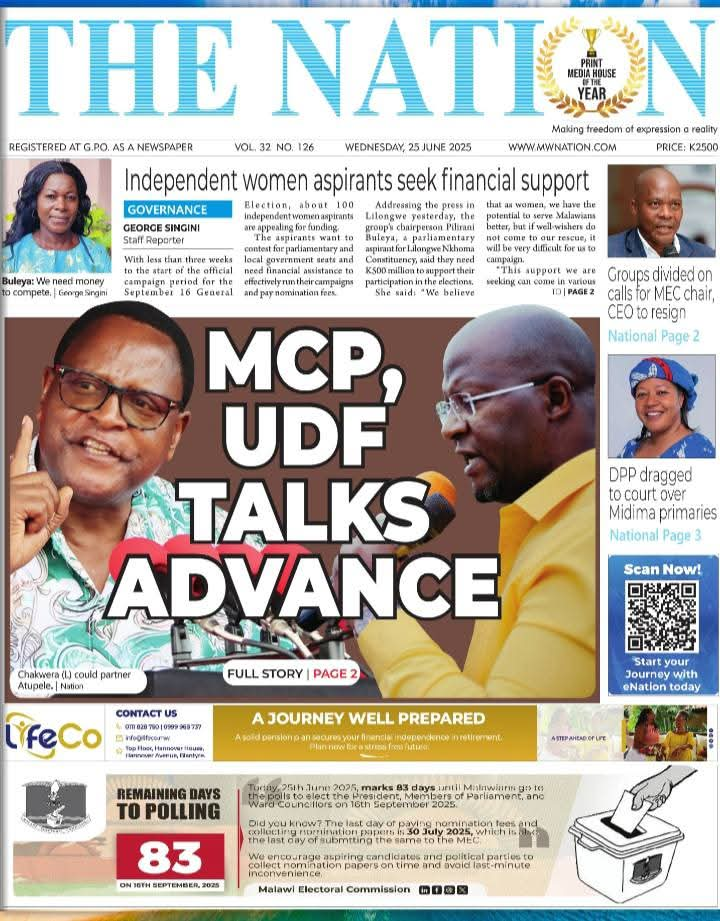Rick Dzida
It is unfortunate that the judges deceived the people of Malawi by claiming that the sole acceptable definition of ‘majority’ in determining the winner of the presidential election is when a candidate receives at least 50% + 1 of the votes cast.
In reality, the decision was a strategy used by the unfair judges to sway Chakwera and Chilima into creating a political coalition for the upcoming 2020 presidential elections, using the nullified results of the 2019 election as a basis.
To be honest, there are numerous countries with democratic systems that use the first past-the-post method to decide the winner of their presidential elections, such as Tanzania, Angola, Singapore, Rwanda, Nigeria, and South Korea.
It is crucial to highlight that the members of parliament who speak on behalf of their constituents strongly opposed the interpretation of ‘majority’ as 50% + 1, before a small group of judicial officials dubbed judges forced it upon our National Assembly.
In principle, obtaining a majority of 50%+1 provides the victorious candidate with a significant endorsement from the electorate. But has this strategy truly been advantageous for the citizens of Malawi compared to a simple majority, as evidenced by the Tonse Alliance government receiving 59.34% of the votes?
In the following, we explore the complexities of the adverse effects that come with implementing a 50% + 1 majority rule in deciding the winner of a Presidential election in Malawi.
For starters, when no candidate achieves the required 50% of the votes, a runoff election is triggered. This can lead to increased costs for both the electoral system and the candidates, as they must campaign again.
Additionally, the time between the initial election and the runoff can prolong uncertainty and may affect voter engagement. Voter turnout in runoff elections can also be lower, which may skew the results in favour of candidates who have a more dedicated base.
Furthermore, the necessity of obtaining a majority can lead candidates to focus on their core supporters rather than attempting to appeal to a broader electorate.
For ins As an example, the present administration focused on encouraging citizens to enroll in large numbers in the Central region, where it has significant backing.
Moreover, in electoral systems with multiple candidates, smaller parties often find it difficult to reach the 50% threshold. This can lead to a lack of representation for diverse viewpoints and interests, as the political landscape may become dominated by larger parties. The 50%+1 majority rule kills smaller parties.
Consequently, voters who support smaller parties may feel disenfranchised, leading to lower voter turnout or the strategic voting phenomenon, where voters choose a less preferred candidate who has a better chance of winning over their preferred candidate who is unlikely to succeed.
Ultimately, electoral alliances are primarily made with the goal of winning elections. However, once in power, conflicts often arise and result in parties breaking away. Eventually, one party gains the most influence.
This is evident in the Tonse Alliance, where disagreements over power sharing caused parties like UTM and PP to withdraw, leaving MCP as the dominant ruling party. The minority MCP is still ruling this country.
In conclusion, the 50% requirement creates a complex electoral environment that influences candidate behaviour, voter engagement, and the overall health of the democratic process.
The implementation of
the 50%+1 majority rule can have both positive and negative effects, such as promoting strategic campaigning, strengthening the president’s mandate, and building coalitions. However, it can also cause a rise in polarization and limit the representation of various political viewpoints.




